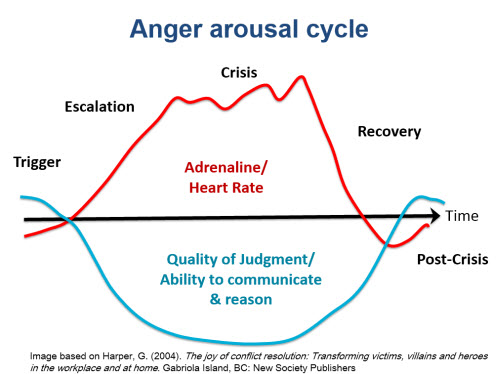Approaching Conflict as an Opportunity for Growth
Before the webinar "Growing Through Conflict: Healthy Workplace Communication," was even over, the participants were already asking for more! WebJunction's own, Anna Shelton shared techniques and skills to approach conflict in our lives. Because conflict can arise in so many formats, our toolbox for handling these challenges also needs to be big and flexible.
Part one: Understanding ourselves
A powerful part of this webinar is the exploration of individual conflict management styles. Have you given much thought to how you handle conflict? Do you postpone issues until you have had time to think about them? Maybe you try to get others to see the logic of your position. In her presentation, Anna explores a variety of conflict styles based on the Thomas-Kilman Conflict Mode Instrument, and shares how we can learn from the different styles and what they tell us about ourselves. She also explores the science behind why we get angry and how we can use the underlying feelings that lead to anger to better understand ourselves and challenging situations.

Part two: Understanding others
You never really know the full story about someone else's thought process or why they take certain actions. We've all been guilty of making up our own narrative about the actions of those around us, particularly when we are frustrated and find ourselves in conflict. This can include filling in the gaps with a story that isn't true or lacks facts. Let's face it, this approach can often be easier than really taking the time and thought to understand a problem! But if something is really bothering you, it's important not to sweep it under the rug, and it's also up to you to surface source of your frustration. Other people can't be expected to know that we are frustrated, or how we are interpreting a situation.
One of the techniques that Anna shares is getting to the facts of a situation by engaging in conversation with people. Here is an approach to having a conversation which explores your own invisible feelings and ways to respond to a conflict situation:

For example, "When you were 15 minutes late to work, I felt anxious because I had to handle the rush by myself." Your colleague may have done everything right and called the supervisor letting them know they were running behind and it could have been for a very legitimate reason. And instead of stewing over the problem, you can free yourself from that by sharing your thoughts and asking for help with understanding the issue. And remember, find a quiet time for these conversations and be prepared to actually engage, not just "fix things."
Other techniques include:
- using open-ended questions that allow you to check your own assumptions and find out if there are needs that can be addressed to reduce conflict.
- learning how to reframe negative statements into a positive needs that can be addressed.
Part three: Facilitating change in our environment
Helping others through conflict and acknowledging their feelings can bring clarity to a situation and lead to resolution. And if you really want to help (and not inflame the situation), there are techniques that you can use when talking about conflict with others. When someone shares a conflict that they are having, consider the following:
- Listen and acknowledge the person's feelings.
- Clarify their goal, what's their biggest concern, what outcome do they want?
- Ask questions such as, "What have you already tried?," "Have you told the person how it impacts you?," or "What do you think is going on in his/her world that may have led to this behavior?"
We often find ourselves as bystanders in conflict and this quote from Eyes on Bullying, is very appropriate: "Depending on how bystanders respond, they can either contribute to the problem or the solution. Bystanders rarely play a completely neutral role, although they may think they do.”
And finally....
Take an hour to watch the full webinar and explore the learner guide that Anna has provided. Maybe even invite colleagues to a "watch and talk" event where you show the webinar and explore the questions in the learner guide as a group. It's a healthy approach to building team communication and creating a healthy workplace for everyone, and it can all start with you!

